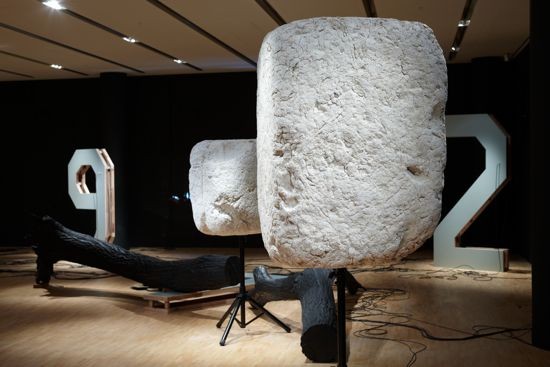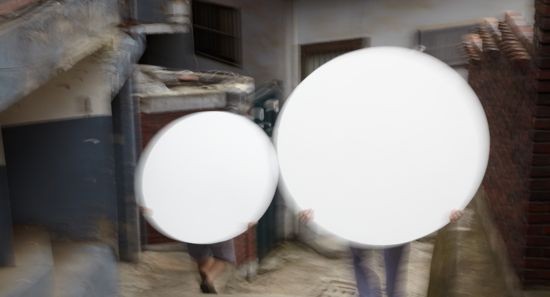October 2 to December 5, 2010
Atelier Hermès, Seoul

Installation view of Sora Kim at Atelier Hermès, Seoul, 2010. All images: Courtesy the artist and Atelier Hermès, Seoul.
Sora Kim is best known for works from the late 1990s and the past decade that engage in mechanisms of gift-giving and spontaneous social interaction. Audiences in Japan, for example, may recall her Capital Plus Credit Union installation from the exhibition “Under Construction” in 2002 at Tokyo Opera City Art Gallery, for which visitors could deposit any object they liked at a counter and expect a return of 3 percent interest in size, weight or quantity, while under the guise of her imaginary Unlimited Concept Co, Kim has incorporated into other projects a cleaning service, travel agency and market.
Kim’s current, untitled exhibition at Atelier Hermès in Seoul finds the artist trading in the discursive process of participatory art for something more inscrutable, and at times even intimidating – an investigation of the thresholds of communication. The exhibition centerpiece is the installation don’t ask me why (all works 2010), comprising 11 free-standing sculptures of numbers constructed at various sizes out of wood and scattered across the main gallery space. Building upon the artist’s longstanding interest in numbers, this work is at once concrete and abstract, real and metaphysical. It orchestrates a confrontation for viewers with the way that numbers so often define our lives, or reduce our lives and their eccentricities to analytical data points, while underscoring the absurdity of the “narratives” that arise from our futile attempts to rationalize everything from consumer behavior to the probability of natural calamities. Adding to the surreal landscape of the same space are also a realistic but clearly artificial life-size cast of a fallen tree and the sprawling sound installation of ambient recordings taken from spots across Seoul, Atlas.
Similarly, two sculptures, both titled Talking to your bones, toy with critical tendencies towards interpretation. Both sculptures feature small square stacks of bricks placed upon white cement pedestals that are in turn displayed on wood and metal shelving units. While the cubic structure of the bricks and pedestals and the grid created by the intersection of the shelf and its vertically oriented wall-mounted bracing evokes a kind of latter-day minimalism, in their heterogeneity of materials and textures these works seem to emerge from concerns unrelated to formal referencing. If anything, they take an established visual language and sabotage it through the insertion of “nonsense words.” Or rather, one gets the sense that Kim is playing dichotomies of meaning and non-meaning and materiality and immateriality off against each other, and exploiting the gaps between these cardinal points of what might be called a Cartesian mode of artistic appreciation.

Still from Turtle Walk (2010), video, 6 min 10 sec.
Interspersed throughout the exhibition are four videos ranging in length from five to 90 minutes. Turtle Walk follows two people carrying on their backs oversized white, circular panels, resembling parabolic antennas, as they walk through the Itaewon neighborhood in Seoul. The longest video, Untitled, documents the burning of a compact car from the point of combustion to the point at which nothing remains but a charred skeleton and smoldering embers. Abstract Reading features actors, filmed at what appears to be an isolated, rocky beach, reciting by memory passages from works by the authors Maurice Blanchot, Italo Calvino, Antoine de Saint-Exupéry and Luis Sepulveda. The shortest video, Daybreak, starts with a scene of a tranquil seaside landscape at daybreak that is then traversed by two men arguing and fighting with each other. Tantalizingly balanced between narrative and portraiture, these videos provide the exhibition an emotional register, shifting in mood between reverie and violence, poetry and rage.
The exhibition certainly has its faults. For both good and bad its sculptural components recall, for example, the “Room” installations of Dominique Gonzalez-Foerster, which bring narrative texts into three-dimensional space through the arrangement of disparate objects, while as mesmerizing as it is, the burning car video, Untitled, could potentially have been made by any number of artists. Nevertheless the exhibition is a revealing glimpse into Kim’s ongoing artistic development, with works that embody the capacity to engage and embrace the diversity of their viewers and the infinite permutations of participation and non-participation that arise from the viewing experience, rather than programming a specific kind of interaction. Contradictorily, this openness (vulnerability even) that escapes articulation seems like a solid place to build on.
